Create the perfect basement home gym with easy tips on equipment, layout, and design. Optimize your space for fitness success!
Why Home Gym?
A home gym helps you stay fit and active at home. Whether you do fitness as a hobby or want to get really strong, you can set up a great workout space in your basement. Learn also about other types of gyms, Let’s see how to make your basement gym the best it can be!
The Benefits of a Home Gym
If you build a home gym for your fitness goals, you will get these benefits:
- Save Money: At first, you might spend some money to set up your gym, but later you’ll save money on gym memberships and travel. Good equipment now can save you money later.
- Exercise Anytime: You can exercise anytime you want, without having to travel anywhere. It’s easy to fit workouts into your day.
- Privacy: You can work out at home without anyone watching. You can wear what you like, listen to your favorite music, and go at your own speed.
- Customize Your Space: You can make your gym just the way you want it. Pick the equipment and decorations that help you reach your fitness goals, whether it’s building muscle, losing weight, or just getting fitter.
Let’s Start;
Making an ideal home gym basement requires careful planning and understanding of what you want to achieve. Whether you want to create a home gym design for specific or all fitness goals, this content is becoming helpful for your purpose. So, scroll down and get the benefit of this guide for your planning about a home gym basement.
1. Space Planning
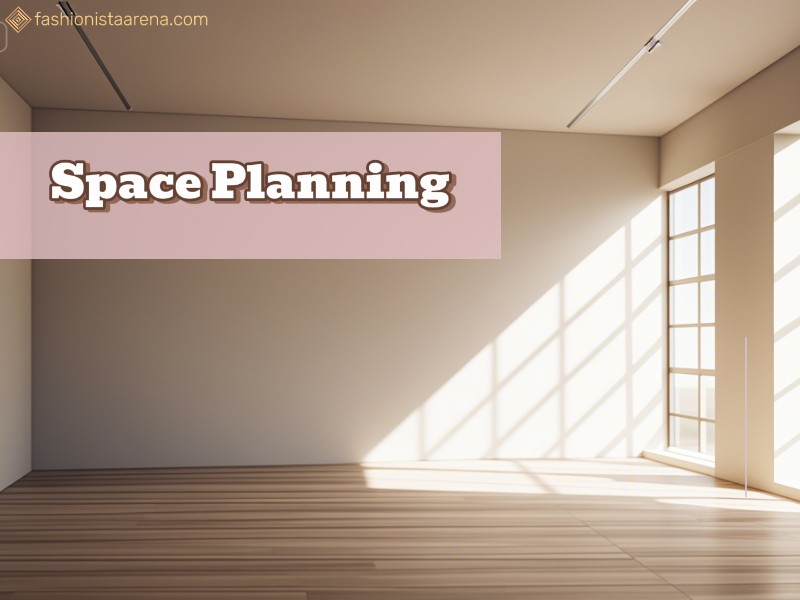
Space planning is the basic and crucial step of a successful home gym basement. It involves not only measuring your available space but also understanding how to best utilize it based on your fitness goals.
➥Space Measurement
Accurate space measurement is crucial when setting up your home gym basement. consider the following key points to measure effectively and plan accrautly.
- Start by measuring the length, width, and height of the entire basement. Include any alcoves, nooks, or uneven areas in your measurements.
- Record these dimensions to create a detailed floor plan.
- Note the locations of any structural elements such as columns, low ceilings, or ducts that might affect equipment placement.
- Consider how these obstructions might impact your workout space and how you can work around them.
- Ensure there is enough space for movement around each piece of equipment.
- Leave clear pathways to avoid overcrowding and to ensure safe usage of your equipment.
2. Determining Fitness Goals
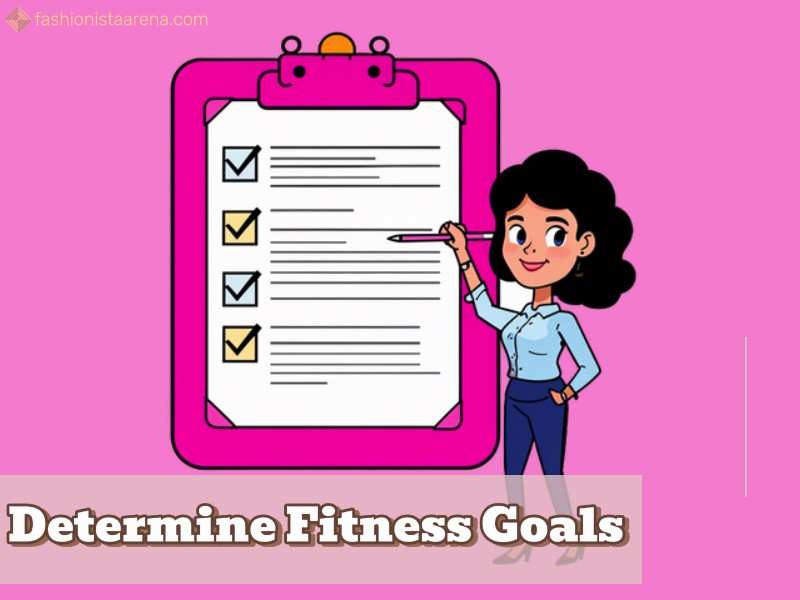
You can have the 2 conditions of fitness goals;
- Specific Fitness Goals
- All Fitness Goals
Your planning for a home gym basement can affect your fitness goals. Here’s how to adjust your space for both specific and general fitness needs:
Home Gym Basement for Specific Fitness Goals
I have no idea what you want for a fitness goal so, I have to create the following structure for every fitness goal;
➥Strength Training
Space
For the strength training zone, set aside approximately 100-150 square feet. This space should be large enough for a power rack, weight bench, and free weights. Make sure there are at least 3-4 feet of space around each piece of equipment so you can move and exercise safely.
Equipment
-
- Power Rack: For squats, bench presses, and other barbell exercises. Ensure it’s placed centrally in the strength training zone.
- Weight Bench: Adjustable benches are ideal for various exercises.
- Dumbbells and Barbells: Invest in a range of weights for versatility.
- Weight Racks: Wall-mounted or freestanding racks for organizing dumbbells and barbells.
- Plate Trees: To keep weight plates organized and easily accessible.
💡 Design Tips:
- Position the power rack and weight bench in a dedicated area with adequate space for safe use.
- Use wall-mounted racks to save floor space and keep the area organized.
➥Cardiovascular Fitness
Space
For the cardiovascular area, allocate approximately 60-100 square feet for each cardio machine. Make sure there’s at least 2-3 feet of space around each machine to use and move safely.
Equipment
-
- Treadmill: A staple for running or walking. Ensure you have enough space behind and around it for safety.
- Stationary Bike: Provides a low-impact cardio workout. Place it in an area where you can easily access it.
- Rowing MachineExcellent for full-body cardio workouts. Ensure there is sufficient space for extending your legs and arms.
💡 Design Tips:
- Arrange cardio machines in a way that allows for unobstructed movement.
- Use a combination of equipment to cater to different cardio preferences.
➥Flexibility and Mobility
Space
For flexibility and mobility zones, allocate approximately 50-80 square feet. This space should be open and clear of obstacles to let you stretch and do yoga comfortably.
Equipment
-
- Yoga Mats: Offer comfort and support during yoga and stretching exercises.
- Foam Rollers: Useful for muscle recovery and self-massage.
- Stretching Bands: For resistance and flexibility exercises.
💡 Design Tips:
- Position mats and rollers in a dedicated area with plenty of space.
- Use wall-mounted hooks or shelves to keep stretching bands and other accessories organized.
➥Weight Loss and Fat Reduction
Space
For the weight loss goal, allocate about 80-120 square feet. This space should be large enough to move around freely and perform various high-intensity and dynamic workouts.
Equipment
-
- HIIT Equipment: Consits items like kettlebells, medicine balls, and battle ropes.
- Cardio Machines: Integrate machines that support high-intensity interval training (HIIT).
- Compact Storage Solutions: Use bins or shelves to keep equipment accessible and organized.
💡 Design Tips:
- Create an open area allowing dynamic movements and quick transitions between exercises.
- Use storage units that can be organized and adjusted to keep the space tidy.
➥Endurance Building
Space
For endurance building, set aside about 60-100 square feet for each cardio machine. Ensure there’s enough space to comfortably use the machines for long workouts.
Equipment
-
- Stationary Bike: Ideal for long-duration cardio workouts.
- Rowing Machine: Provides a full-body workout for building endurance.
- Interval Timer: Useful for tracking workout intervals and rest periods.
💡 Design Tips:
- Arrange equipment to facilitate continuous and uninterrupted workouts.
- Ensure there is sufficient space around each machine for comfort and safety.
Home Gym Basement for All Fitness Goals
➥Space Planning (Zoning, Accessibility)
Zoning
Divide your basement into specific zones for different types of workouts. For example, have separate areas for strength training, cardio, flexibility, and functional training. Some areas can serve multiple purposes, such as a space for both stretching and bodyweight exercises.
Accessibility
Arrange equipment so that it’s easily accessible and doesn’t obstruct pathways. Maintain clear pathways between equipment to allow for smooth movement and safety during workouts.
➥Equipment for All Fitness Goals
Here’s a comprehensive table summarizing the essential equipment for a home gym basement designed to accommodate all fitness goals:
| Fitness Goal | Equipment | Space Requirements |
|---|---|---|
| Strength Training | Power Rack, Weight Bench, Dumbbells, Barbells | 100-150 sq. ft. with 3-4 ft. clearance |
| Cardiovascular | Treadmill, Stationary Bike, Rowing Machine | 60-100 sq. ft. per machine, 2-3 ft. clearance |
| Flexibility and Mobility | Yoga Mats, Foam Rollers, Stretching Bands | 50-80 sq. ft. |
| Weight Loss | HIIT Equipment, Cardio Machines | 80-120 sq. ft. |
| Endurance Building | Stationary Bike, Rowing Machine, Interval Timer | 60-100 sq. ft. |
3. Flooring Design for Both Conditions

Choose the right flooring for safety and comfort in your home gym basement. Here’s a guide to selecting and designing flooring based on your fitness goals:
➥Specific Fitness Goals
Strength Training
Rubber flooring is strong and durable, perfect for heavy lifting. Interlocking rubber mats are easy to put down and replace, and they protect both your floor and equipment.
Cardiovascular Fitness
Foam flooring is gentle and ideal for low-impact cardio workouts. Rubber flooring is also good for cardio, as it’s durable and provides a non-slip surface.
Flexibility and Mobility
Foam tiles offer cushioning and comfort for yoga and stretching. Yoga mats are also perfect for individual stretching and flexibility exercises.
Weight Loss and Fat Reduction
Rubber flooring is tough and great for high-intensity workouts. Foam flooring is also soft and provides comfort for different types of exercises.
Endurance Building
Rubber flooring is durable and comfortable for long workouts. Foam or vinyl flooring also provides a flat, non-slip surface and is easy to maintain.
➥All Fitness Goals
Versatility
Consider using interlocking rubber mats or high-density foam tiles for modular flooring. These options work well for different exercises and equipment.
Durability
Rubber flooring is perfect for withstanding the wear and tear from various equipment and workouts. Foam tiles provide cushioning and can be used for a variety of activities.
Comfort and Safety
Make sure the flooring has good non-slip properties to prevent slips and falls while exercising.
4. Add Mirroring and Monitors
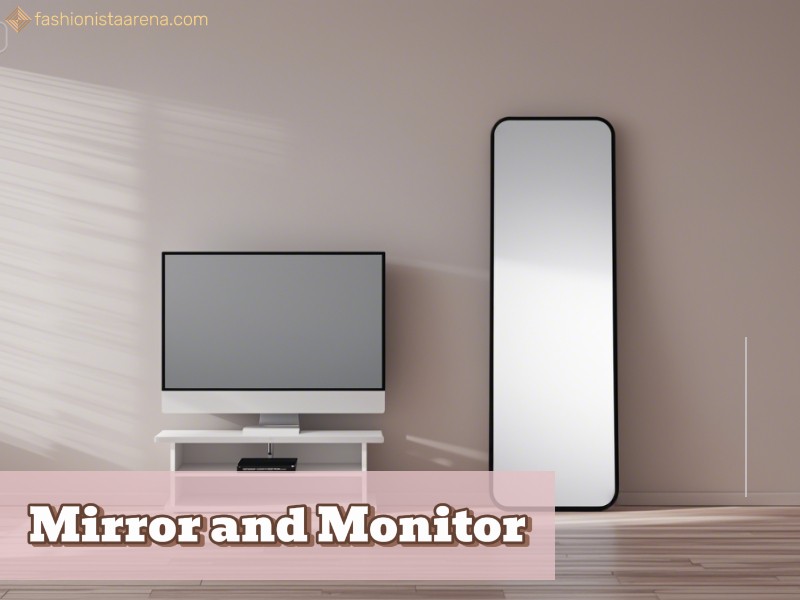
Mirrors and monitors can enhance your workout experience by allowing you to check your form and stay motivated.
➥Mirrors
Install full-length mirrors to help check your form and technique, especially during strength training and flexibility exercises. Place the mirrors where you do exercises like squats, deadlifts, and yoga poses to ensure you’re using proper technique.
➥Monitors
Set up monitors to show workout videos or virtual classes for guidance and motivation. They can also help you monitor your performance, track progress, and set goals.
💡 Design Tips:
- Ensure monitors and mirrors are positioned for optimal visibility without obstructing movement or access to equipment.
- Use wall-mounted options to save space and keep the area clean
5. Manage Sound System

A well-designed sound system can enhance your workout experience by keeping you motivated and focused.
➥Speakers
Set up high-quality speakers around the gym to ensure clear and balanced sound. Place them carefully to avoid distortion and ensure the sound reaches every corner of the space.
➥Soundproofing
To reduce noise, add soundproofing materials to make your workout space quieter. Use acoustic panels, carpets, or heavy curtains to absorb sound and cut down on echo.
💡 Design Tips:
- Choose a sound system that is easy to control and adjust based on your workout needs.
- Ensure the sound level is comfortable and motivating without being overwhelming.
6. Consider Climate Control
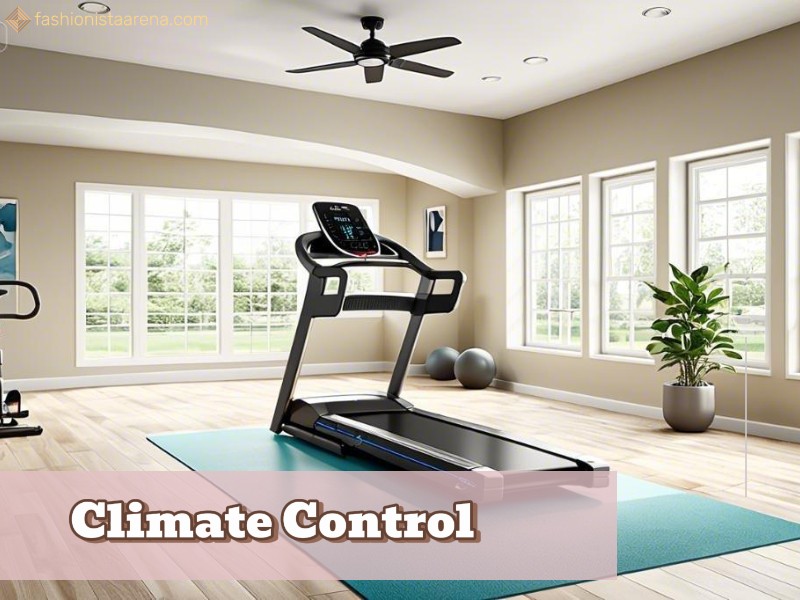
Maintaining a comfortable temperature and airflow is essential for an effective and enjoyable workout.
➥Ventilation
Use ceiling or floor fans to improve air circulation and keep the space cool. To improve airflow and air quality, think about adding an HVAC system or an air purifier.
➥Heating/Cooling
For climate control, install a heating or cooling system to keep the temperature pleasant year-round based on your local climate. Use thermostats to manage the temperature and keep it comfortable during your workouts.
💡 Design Tips:
- Ensure ventilation and climate control systems are unobtrusive and do not interfere with your workout space.
- Regularly maintain and clean these systems to ensure optimal performance.
7. Adopt Safety Considerations 
Ensuring safety is a key factor when designing your home gym basement. Here’s how to create a safe workout environment:
➥Flooring
Pick flooring that is non-slip and impact-resistant to prevent slips and injuries. Regularly check the flooring for wear and tear and fix any problems quickly.
➥Equipment Placement
Make sure all equipment is securely anchored and stable, and check for any loose parts or hazards. Keep pathways clear around equipment to prevent accidents and ensure easy access.
➥Emergency Access
Keep pathways to exits clear and make sure emergency exits are easily accessible. Make sure to keep a well-stocked first aid kit easily accessible for any minor injuries or emergencies.
💡 Design Tips:
- Conduct regular safety checks and maintenance to ensure equipment and flooring remain in good condition.
- Make sure everyone is informed about how to use the equipment correctly and follow safety guideline.
8. Make Decoration
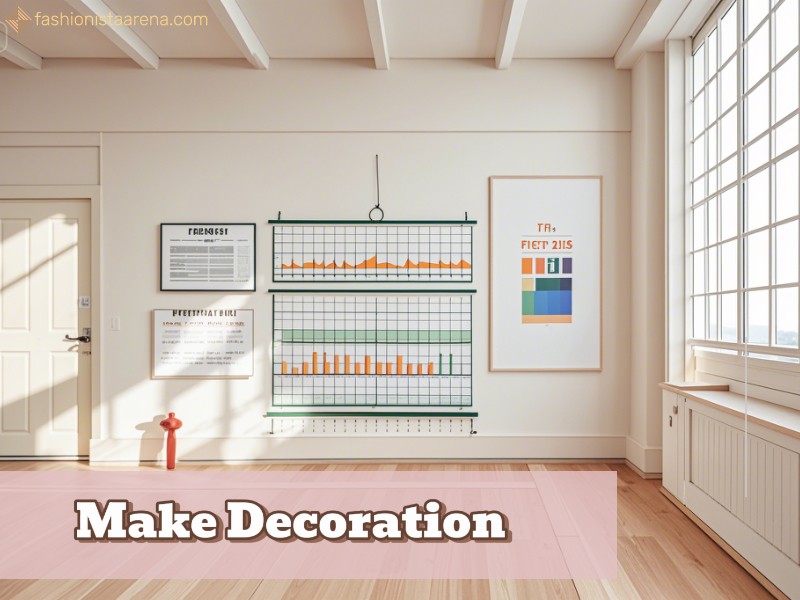
If you add creative and decorative posture in your gym room, it can be beneficial for your motivation and confidence in your fitness journey.
➥Aesthetics
Choose a color scheme that motivates and energizes you, whether it’s bright or calming. Add motivational posters or artwork to inspire and keep you focused during your workouts.
➥Lighting
Use bright lighting to make your workout space lively and energizing. Consider adding adjustable lighting to match different activities. Also, adjust task lighting around mirrors or equipment to improve visibility.
💡 Design Tips:
- Personalize the space with items that reflect your style and motivation.
- Ensure that decor and lighting do not obstruct equipment or interfere with workouts.
9. Fitness Technology

Incorporating fitness technology can enhance your home gym basement experience by providing additional functionality and tracking capabilities.
➥Equipment Integration
Always invest in smart fitness equipment that tracks your workouts, offers virtual classes, or connects with fitness apps. Make sure the equipment can easily connect to your devices for smooth integration.
➥Tracking Devices
Use fitness trackers, heart rate monitors, and smartwatches to track your progress and set goals. Track important metrics like heart rate, calories burned, and workout duration to assess your performance and make any necessary adjustments.
💡 Design Tips:
- Choose technology that complements your workout routine and enhances your overall fitness experience.
- Ensure that technology is easily accessible and integrates well with your gym setup.
Final Thoughts
By following this comprehensive guide, you can transform your home gym basement into a functional, motivating, and safe space tailored to your specific fitness goals and overall workout needs. By the way, you can also consult with professional for more enhancement. Whether you’re focusing on strength training, cardiovascular fitness, flexibility, or a combination of all, thoughtful planning and the right equipment will help you achieve your fitness objectives and enjoy a rewarding workout experience.
- Honey & Sweet Almond Oil for Face-Simple Recipe and Benefits - September 11, 2024
- Is Almond Oil Good for Skin, Hair, Nail & What’s Potential Benefits? - September 11, 2024
- 8 Most Effective Oils for Your Nail Cuticle Health - September 10, 2024


